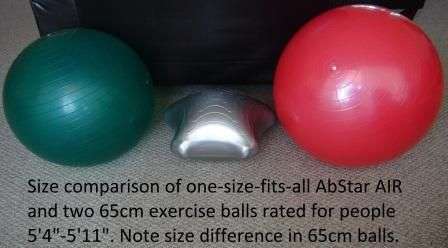Which Exercise Ball Size?
“An exercise ball is a ball constructed of soft elastic with a diameter of approximately 35 to 85 centimeters (14 to 34 inches) and filled with air. The air pressure is changed by removing a valve stem and either filling with air or letting the ball deflate. It is most often used in physical therapy, athletic training, and exercise. It can also be used for weight training.
The ball, while often referred to as a Swiss ball, is also known by a number of different names, including balance ball, birth ball, body ball, ball, fitness ball, gym ball, gymnastic ball, physioball, pilates ball, Pezzi ball, sports ball, stability ball, Swedish ball, therapy ball, or yoga ball.” – Source: Wikipedia
Exercise Ball Sizes
Exercise balls and other inflatable fitness products like the Exercise Star (aka AbStar AIR) were invented to add instability to workout routines. The aspect of instability requires the engagement of more muscles in continuously varying ways. Engaging those muscles is required, so the exerciser can maintain body balance and complete the exercise repetitions.
One of the problematic issues with buying an exercise ball is determining which exercise ball size to buy. Consider the following size charts and sources.
Inconsistent Sizing
From POPSUGAR.com:
Ball size Height
55cm 4’11” to 5’4″
65cm 5’4″ to 5’11”
75cm 5’11” to 6’7″
From Gaiam.com:
Ball size Height
Small: 55cm/22″ 5’0″ to 5’5″
Medium: 65cm/26″ 5’6″ to 5’11”
Large: 75cm/30″ 6’0″ to 6’3″
From spine-health.com:
Ball size Height
55cm 5’1″ to 5’8″
65cm 5’9″ to 6’2″
75cm 6’3″ to 6′ 7″
85cm 6’8″ and taller
As you can see, there are wide discrepancies between these charts. Every manufacturer, retailer, brand, and source may differ in sizing. Additionally, although user height versus the size of the ball seems to be a reasonable measure, one’s torso length may affect the size of the ball needed more than height.
For example, a person with a long torso with relatively short legs may need an entirely different size ball than someone of the same height but a shorter torso. Thus, body proportions, not only height, will affect proper sizing.
What to Do
One solution is to try out a ball at a local sporting goods store. That is, assuming the store has enough room to inflate balls of several sizes for display and testing. Most retailers do not, but they may offer several boxes of various makes and sizes of balls.
These balls may or may not have size charts, which you may or may not be able to trust. Considering the conflicting charts and information, it seems impossible to size an exercise ball properly, especially when ordering online.
For instance, the featured image above shows two 65cm models flanking a one-size-fits-all Exercise Star (aka AbStar AIR). Our core trainer is, for reference, only about ten inches (25.4 cm) high. Note that each ball, though fully inflated, is significantly different in height. Those differences are likely due to different manufacturer size scales, molds, source materials, and molding processes.
Which Exercise Ball Size is Best?
Which exercise ball size would you order? It can be a confusing question, because of vastly different sizing by different manufacturers.
We suggest you buy the Exercise Star instead and end your confusion about which exercise ball size is right. The best answer to the above question may be “neither.”
Each Exercise Star is produced in only one factory. That factory uses special AbStar molds of the same size and shape, along with the same materials and advanced rotational molding process in every manufacturing run.
With its anti-slip base, the Exercise Star stays where you put it, and it is safer, more versatile, and more effective than a ball. Only ten inches high, twenty inches in diameter, and 3.5 lbs., the Exercise Star is easy to carry, move and store. Its thicker material and 500 lb. rating mean the Exercise Star offers better support for exercisers. Its design and construction make for more efficient core and stability training while offering enough resilience for effective resistance training.
Apparently, “which size” was a trick question, because the choice is clear. Buy the safer, more versatile, and more effective, one-size-fits-all Exercise Star instead of a ball.
If you enjoyed this article, you might also like our posts on how to lose body fat and how to achieve more effective ab workouts.
Yours in health,
Team AbStar
Disclaimer: The above is the opinion of the author. Use it at your own risk. As always, consult with your doctor before beginning any nutritional or exercise program.

